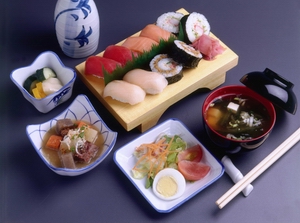 y that screens cultural asset candidates has recommended that “washoku, traditional dietary cultures of the Japanese,” gain the status, the Cultural Affairs Agency said Tuesday.
y that screens cultural asset candidates has recommended that “washoku, traditional dietary cultures of the Japanese,” gain the status, the Cultural Affairs Agency said Tuesday.An intergovernmental panel is expected to make a final decision on listing the Japanese food culture at a meeting in Azerbaijan in early December.
Currently, 21 Japanese assets, all designated as important cultural assets by the government, are on the UNESCO Intangible Cultural Heritage list. Washoku would be the first Japanese asset related to food to make the list.
The government proposed washoku in March 2012, saying it is closely “associated with an essential spirit of respect for nature.”
“Washoku has developed as part of daily life and with a connection to annual events” such as New Year’s celebrations and rice planting, and “is constantly re-created in response to changes in human relationship with natural and social environment,” the government said, adding that washoku also “has important social functions for the Japanese to reaffirm identity, to foster familial and community cohesion, and to contribute to healthy life.”
Washoku is nutritionally well-balanced and thus contributes to long life and the prevention of obesity, the government stressed in its proposal to UNESCO.
Japan also sought washoku’s registration as a UNESCO Intangible Cultural Heritage to dispel false information about the safety of Japanese food amid the Fukushima nuclear crisis.
At present, 257 items, including oral traditions, performing arts, social practices, rituals, and knowledge and skills to produce traditional crafts have received the UNESCO designation.
The 21 Japanese items on the list are eight government-designated important intangible cultural assets, including kabuki and noh, and 13 important intangible folk cultural assets, including traditional dance of the Ainu.
Four food-related items are on the list. They are French cuisine, the Mediterranean diet in Spain, Greece, Italy and Morocco, Mexican cuisine and “keskek,” a traditional ceremonial dish in Turkey.





